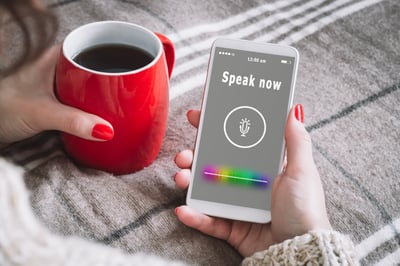

Naturally, humans are visual creatures.
We crave visual forms of content. There’s science behind this claim. Neurons devoted to visual processing make up about 30% of the human brain cortex, compared to 8% for touch and 3% for hearing.
This natural predisposition shapes us as consumers. We tend to judge products based on whether we visually like them or not. And while it’s quite easy to cater to individual preferences and tastes when shopping, sometimes you just fall for a perfect table that you saw in a coffee shop. You think about it during the day and can’t sleep at night wishing you knew where to buy it. This is where visual search comes in – a technology that meets human nature.
The visual search industry has developed significantly over the past decade, integrating technology with neuroscientific knowledge. In this article, we will analyze recent progress made by the industry’s top players and discuss what marketers can do at the moment to make the most out of visual search.
Visual search is a solution that fills the gaps where words fail to describe what the customer is trying to find. It identifies objects within an image and searches for other, similar ones.
Visual search solutions utilize artificial intelligence and machine learning technologies, which means that such systems are constantly improving based on the experience they gain. In short, the more images a visual search engine has analyzed, the more precise it becomes.
The technology uses visuals as ‘queries,’ and analyzes shapes, colors, and sizes to find the best matching search results. Following the example of the perfect table, if you take a picture of it, visual search can help you find and shop either identical or very similar tables.
It was back in 2017 when Ben Silbermann, CEO of Pinterest said “the future of search will be all about pictures, not keywords.” Since then, the industry’s key players have invested heavily in research to develop and improve their visual search applications: back in 2017, the image recognition market was valued at $17,911 million, and it is projected to reach over $86 million by 2025.
It’s not only the technology that is constantly developing; the demand for visual search solutions is also growing. According to MarketWatch, 62% of Millenials and Gen Z prefer visual search over any other new technology.
With intelligent visual search technology being incorporated into apps, websites, and prominent platforms such as Amazon, Pinterest, and Google, visual search is irreversibly changing the search marketing landscape.
Google’s visual search engine, Google Lens, has found wide application in everyday activities. Among others, it helps with:
The New York Times went one step further this March; their newly released annual music issue allows readers to unlock additional content using Google Lens.
By pointing a camera at the magazine’s cover, the readers are directed to a video conversation between NYT’s EIC, Jake Silverstein, and designer Gail Bichler about the cover’s behind the scenes story. While browsing through the print magazine, readers can also listen to the Times’ dedicated playlists and podcasts and save articles to the Times’ app through Google Lens.
The idea is to engage readers with additional content and provide a unique, multi-sensory experience. Nevertheless, the collaboration is somewhat of an experiment. Eddie Chang from Google said that if it turns out to be a success, Google will partner with other media companies.
If you’re on Pinterest, you’ve definitely spotted the tiny magnifying glass button located in the bottom right corner of every pin.
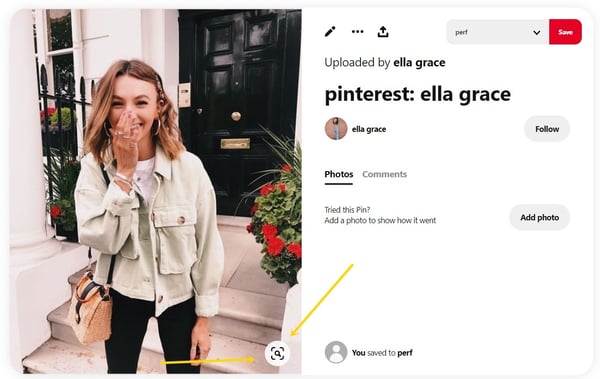
It’s the Pinterest Visual Search Tool, which is a dream come true if you’re in retail and using the platform to market your products. By clicking on the button, Pinterest users are able to hover over a particular product pictured in the pin. Retail image recognition software is an important function for retail establishments. The visual search technology will pull up more content featuring that particular product, helping them to find the retailer.
As a marketer, remember to redirect to your category page if your product is not available anymore. Otherwise, you’ll miss out on potential sales.
Pinterest has recently upgraded their visual search engine by introducing the Pinterest Lens. The Lens feature lives behind the tiny camera icon within Pinterest’s search bar. Once you click on it, you’ll be able to quickly upload or take a photo, and Pinterest will pull up similar images for you. What’s more, the tool is now integrated with shoppable fashion and home product pins, redirecting users directly to the checkout page on the retailer’s site.
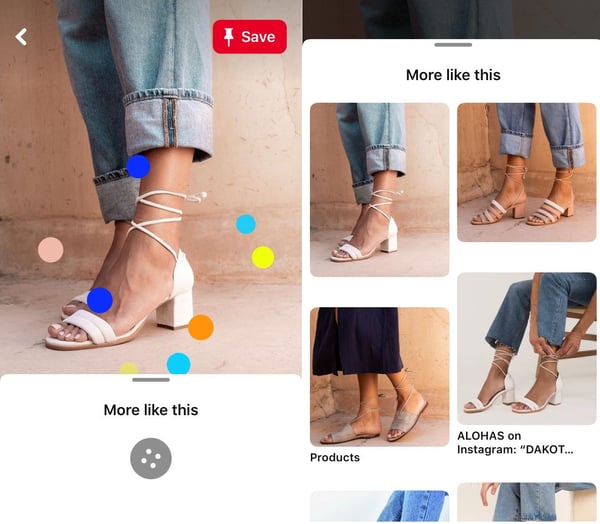
Pinterest also developed Shop the Look Pins, a free product-tagging tool for fashion and home decor. Anyone with a business account can manually tag items using a self-serve tool. The tags appear as small white dots. When users tap on one of the dots in a Shop the Look Pin, they’ll see more information, including pricing and availability, and a link to buy the item. It’s clear that this feature, combined with visual search, can bring tangible sales results.
Amazon introduced their first visual search tool as early as 2009. Back then, users were able to use it for books and CDs. The company subsequently upgraded their visual search solutions, adding additional items. The feature can now be used for all kinds of products.
Recently, Amazon found a unique way to make the most out of visual search. They introduced an augmented reality (AR) view that lets you preview products in your space virtually prior to making a purchase. You can see how products fit in your home and choose from different styles to design your space. Moreover, every product is sized and rendered to scale which gives you a reliable image of how it would look like in reality.

In collaboration with Amazon, Snapchat introduced a visual search engine in 2018. The general idea was to let users identify products just by capturing them within the photo frame, and easily order the recognized elements through Amazon.
In addition, the app allows users to scan barcodes in order to access product information. Once a product is recognized, the app displays an Amazon product card showing the item and similar ones along with their titles, prices, thumbnails, average review scores, and Prime availability. Users can simply tap on the card and order the product on Amazon.
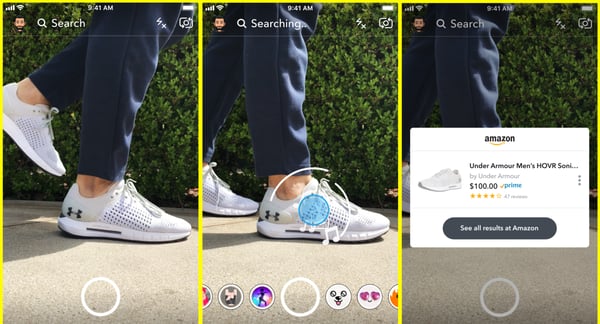
In 2017, eBay launched their visual search engine claiming that the technology would “make the whole internet shoppable”. The app offers two features: Find It On eBay and Image Search.
Find It On eBay allows the app’s users to upload images from any social media profile or web page. Once that’s done, the app displays listings of either the indicated item or other, similar ones.
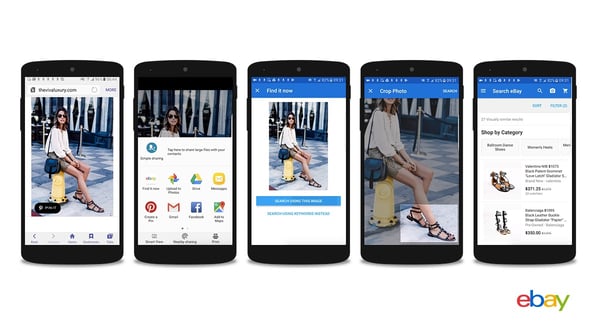
With Image Search, users can upload photos from their camera roll or take a photo at the very moment and apply the image to the eBay search bar. The app then displays listings that match the item in the photo.
Content is king. You’ve probably heard that a million times. But actually, visual content is the true ruler. According to Contently’s recent report, 78% of marketers always use visuals in their digital communications. What’s more, 75% say their results are better when using visual assets in their digital marketing.
While creating your content strategy, you shouldn’t forget about its less amusing but crucial part, optimizing your visuals for better search results.
The image title plays an SEO role similar to blog post titles, and as in the case of blog post titles, it should contain a relevant keyword. It’s best to use either long-tail or location-based keywords. Long-tail keywords help your website’s ranking in Google.
The more precise the keyword, the better the chances that people with a solid purchase intent will find you in Google search results. For example, “mid-century wooden coffee tables” will give you better results than just “wooden tables”. Location-based keywords will display your content for users in a defined area, for example, “mid-century wooden tables in Florida”.
In simple words, alt text is what will replace your image in search results if, for example, a user’s internet connection is too weak to upload images. But alt text is more than that. Search engines use it to understand what your image is and how to rank it via SEO meta tags. So apart from your target keywords, try to use these 125 characters to describe the image as accurately as possible.
If the content management platform you use allows image descriptions, make sure to fill it in. Descriptions give you space to provide context for the image and further insights into what you’re offering. It should be compelling and consistent with your brand image. And obviously include your keyword(s).
Both size and format are crucial factors that affect website speed and can make your content load very slowly or not at all. It’s usually best to go for JPEGs; this format is small in size and does not compromise image quality. Use PNGs for images with transparent backgrounds. Keep in mind that image dimensions should not exceed the average desktop screen resolution, which is up to 2,560 pixels in width in most cases.
These are the general, universal guidelines, but it is also important to optimize your content for specific media outlets. Before you even start to create your content, make sure it meets the guidelines of your target medium.
For example, on Pinterest the ideal pin size is 600 x 900 pixels. When posting to social media, always look up recommended image sizes and remember to fit the style and contents of your visuals to every individual platform's audience.
Apart from the obvious benefit of optimizing for image search, better organic visibility, marketers have many reasons to be interested in the technology.
Following the example of The New York Times and its recent annual music issue, be creative and consider incorporating visual search engines into your marketing strategy to provide your customers with an omni-sensory experience. You can also go for a long-term collaboration and incorporate AI tools into your offer. For example, if you’re in the fashion industry, you may think about partnering with tools such as Intelistyle that generate outfit recommendations based on what your customers are interested in.
Look for apps and websites dedicated to your niche. For example, if you’re in the furniture industry, look into adding your product content to Living Spaces, a visual designer tool that allows people to use their product base in visual projects.
Once you research trends using visual search, use your insights to reverse engineer the content creation process. Research-driven content creation is key to getting your products in front of valuable audiences – trends and competitive analysis will help you pin down the best practices.
Although still in its early days, visual search is developing at an incredible rate. Top industry players are already investing big dollars in research and experimental development which further speeds up the process. Digital marketers should keep an eye on this trend. By adapting to consumers’ natural preference for visual content, brands are bound to succeed.
Become more adept at using VR visualization software tools to bring visual search to the forefront of your marketing strategy today.
Kasia Majewska is a Marketing Executive at NapoleonCat, and a greeting-dogs-on-the-street kind of person.
Which would you understand more easily - a block of text explaining how to tie a Double...
 by Kelly Wade
by Kelly Wade
Paid search helps ads land directly on the search engine results page (SERP).
 by Sagar Joshi
by Sagar Joshi
As if having a sound social circle to interact with wasn’t enough, humans have begun talking...
 by Kevin Reis
by Kevin Reis
Which would you understand more easily - a block of text explaining how to tie a Double...
 by Kelly Wade
by Kelly Wade
Paid search helps ads land directly on the search engine results page (SERP).
 by Sagar Joshi
by Sagar Joshi
Never miss a post.
Subscribe to keep your fingers on the tech pulse.



